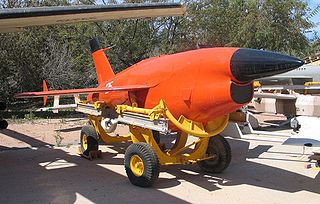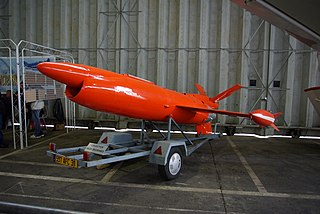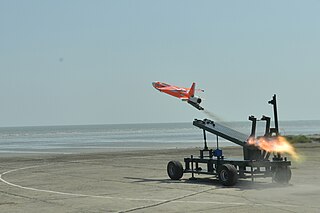
The RIM-162 Evolved SeaSparrow Missile (ESSM) is a development of the RIM-7 Sea Sparrow missile used to protect ships from attacking missiles and aircraft. ESSM is designed to counter supersonic maneuvering anti-ship missiles. ESSM also has the ability to be "quad-packed" in the Mark 41 Vertical Launch System, allowing up to four ESSMs to be carried in a single cell.

The Beechcraft AQM-37 Jayhawk is an air-launched supersonic target drone manufactured by Beechcraft capable of simulating inbound ICBM warhead packages for fleet shoot-down exercises.

The BQM-74 Chukar is a series of aerial target drones produced by Northrop. The Chukar has gone through three major revisions, including the initial MQM-74A Chukar I, the MQM-74C Chukar II, and the BQM-74C Chukar III. They are recoverable, remote controlled, subsonic aerial target, capable of speeds up to Mach 0.86 and altitudes from 30,000 to 40,000 ft.

The Canadair CL-89 is a surveillance drone (UAV) produced jointly by Canada, Britain and West Germany in the 1960s. A larger and improved model with a greater payload, the CL-289, was later introduced.

The Ryan Firebee is a series of target drones developed by the Ryan Aeronautical Company beginning in 1951. It was one of the first jet-propelled drones, and remains one of the most widely used target drones ever built.

The MQM-61 Cardinal is a target drone designed and built by Beechcraft.

The BAI Aerosystems (BAIA) BQM-147 Dragon unmanned aerial vehicle is a tactical battlefield UAV operated by the United States Marine Corps. Originally designed as an expendable communication jammers, they were converted into a reconnaissance role with the addition of a camera.
The Microturbo TRI-40 is a small turbojet engine developed for use in cruise missiles and small unmanned aerial vehicles in the 2.2 - 3.6 kN thrust class.

The Microturbo TRI 60 is a small, expendable turbojet engine developed for use in cruise missiles, target drones, and other small unmanned air vehicles. Variants of this engine produce from 3.5 to 5.3 kN of thrust. The engine first ran in 1974.

The Beechcraft MQM-107 Streaker is a reusable, turbojet powered, target towing drone primarily used by the United States Army and the United States Air Force for testing and training. The US Army uses the drone for testing various surface-to-air missile systems such as the FIM-92 Stinger and the MIM-104 Patriot. The US Air Force uses them in practice engagements for their air-to-air missiles like the AIM-9 Sidewinder and the AIM-120 AMRAAM.
Aérospatiale C.22 is a subsonic target drone developed and manufactured by Aérospatiale since 1980, and used in testing the MBDA Aster missile. It is powered by a Microturbo TRI 60-02.

The Interstate XBDR was a design for an assault drone - an early television-guided missile - powered by two jet engines, that was designed by the Interstate Aircraft and Engineering Corporation during the latter stages of the Second World War for use by the United States Navy. Wind tunnel tests of a scale model were conducted, however no full-scale examples of the aircraft were built before the project was cancelled.

The Radioplane Q-1 was an American target drone, developed in the early 1950s for the United States Air Force by the Radioplane Company. Originally powered by a pulsejet engine, then later developed as an improved turbojet-powered aircraft, the Q-1 failed to win the favor of the USAF. However, the aircraft provided the basis of the GAM-67 Crossbow anti-radar missile.

The Nord Aviation CT20 was a French turbojet-powered radio-controlled target drone introduced in 1957. Developed from the Arsenal / S.F.E.C.M.A.S. T.5.510, the CT.20 was built by Nord Aviation and powered by a Turbomeca Marboré II engine, providing a top speed of 900 km/h and a flying time of 55 to 60 minutes. It has been noted for its similarity to the Ryan Firebee. The unmanned drone was used in the development of air-to-air missiles following the Second World War.

The NSRDC XBQM-108A was an experimental VTOL unmanned aerial vehicle developed by the United States Navy during the 1970s. Although the XBQM-108A successfully conducted unmanned, tethered flight tests and the project was canceled before any free flights could be conducted.

The DRDO Abhyas is a high-speed expendable aerial target being built by the Aeronautical Development Establishment (ADE) of the Defence Research and Development Organisation (DRDO) for the Indian Armed Forces.

The Boeing CQM-121 Pave Tiger is an unmanned aerial vehicle developed by Boeing for use by the United States Air Force. Intended for the Suppression of Enemy Air Defenses (SEAD) role, the drone reached the flight-test stage before cancellation.

The Composite Engineering BQM-167 Skeeter is a subscale aerial target (drone) developed and manufactured by Composite Engineering Inc. and operated by the United States Air Force and certain international customer air forces. It replaced the Beechcraft MQM-107 Streaker.
The Republic SD-4 Swallow was an early high-speed reconnaissance drone developed by Republic Aviation for the United States Army. Intended for use by the U.S. Army Signal Corps to target tactical ballistic missiles, it was cancelled before the first prototype could be completed, and did not see operational service.

The Kratos BQM-177 is a subsonic aerial target drone (SSAT) for emulating anti-ship cruise missiles. It was developed by Kratos Defense & Security Solutions and is currently operated by the United States Navy as the BQM-177A. The variant intended for international customers is designated BQM-177i.

















